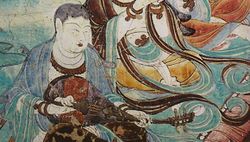كهوف يولين
كهوف يولين (الصينية: 榆林窟; پنين: Yulin kū؛ إنگليزية: Yulin Caves) هو موقع معبد كهفي بوذي في ناحية گواژو، مقاطعة گانسو، الصين. ويقع على بعد نحو 100 كم شرق البلدة الواحة دخان وكهوف موگاو. وتأخذ اسمها من eponymous elm trees lining the Yulin River, which flows through the site and separates the two cliffs from which the caves have been excavated. The forty-two caves house some 250 polychrome statues and 4,200 m2 of wall paintings, dating from the Tang Dynasty to the Yuan Dynasty (seventh to fourteenth centuries).[1][2] The site was among the first to be designated for protection in 1961 as a Major National Historical and Cultural Site.[3] In 2008 the Yulin Grottoes were submitted for future inscription on the UNESCO World Heritage List as part of the Chinese Section of the Silk Road.[4]
الكهوف
Most of the caves take the form of an entrance corridor, antechamber, and main chamber. In three caves, a central pier was left intact during excavation then carved with niches on all four sides. A number of caves were reworked and repainted in later periods, since the site remained in use throughout the تانگ، الأسر الخمس، سونگ، شيا الغربية، and يوان Dynasties. It fell into disuse during the Ming Dynasty. There were early efforts to restore the caves at the time of the Qing Dynasty and several new caves also date to this period. More recently, under the management of the Dunhuang Academy، the focus has been on preventive conservation through consolidation of the cliff face and controlling access.[1][5]
رسوم جدارية
The paintings are Buddhist with some secular scenes, the former including buddhas، bodhisattvas، apsara، and jataka tales; and the latter, donor portraits, go players, representatives of China's ethnic minorities، marked out by their hair styles and dress, farming scenes such as milking a cow, wine-making, a smelting furnace, and a marriage ceremony; depictions of musicians and dancers help break down the distinction between the sacred and the profane.[1][2] The paintings are not frescoes but instead executed on an earthen render with mineral and organic pigments and gum or glue binders.[5]
قائمة الكهوف
The forty-two caves are dated as follows, based largely on the style of the paintings and their accompanying inscriptions (in Chinese، Mongolian، Tibetan، Sanskrit، Tangut، and Old Uighur):[6][7]
| الكهف | الإنشاء | الترميمات | الترقيم السابق | الصورة |
|---|---|---|---|---|
| الكهف 1 | تشينگ | |||
| الكهف 2 | شيا الغربية | يوان، تشينگ | C1 | 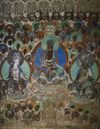
|
| الكهف 3 | شيا الغربية | يوان، تشينگ | C2 | 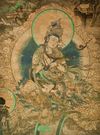
|
| الكهف 4 | يوان | تشينگ | C3 | 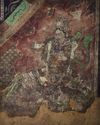
|
| الكهف 5 | تانگ | تشينگ | 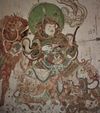
| |
| الكهف 6 | تانگ | الأسر الخمس، سونگ، شيا الغربية، تشينگ، Republic of China | C4 | |
| الكهف 7 | تشينگ | |||
| الكهف 8 | تشينگ | |||
| الكهف 9 | تشينگ | |||
| الكهف 10 | شيا الغربية | يوان، تشينگ | C5 | 
|
| الكهف 11 | تشينگ | |||
| الكهف 12 | الأسر الخمس | تشينگ | C6 | 
|
| الكهف 13 | الأسر الخمس | سونگ، تشينگ | C7 | |
| الكهف 14 | Song Dynasty | تشينگ، Republic of China | C8 | |
| الكهف 15 | Mid-تانگ | سونگ، شيا الغربية، يوان، تشينگ | C9 | 
|
| الكهف 16 | الأسر الخمس | Early Republic of China | C10 | |
| الكهف 17 | تانگ | الأسر الخمس، سونگ، (date unclear), تشينگ | C11 | |
| الكهف 18 | الأسر الخمس | شيا الغربية، يوان | C11b | |
| الكهف 19 | الأسر الخمس | تشينگ | C12 | 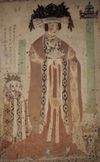
|
| الكهف 20 | تانگ | الأسر الخمس، سونگ، تشينگ | C13 | |
| الكهف 21 | تانگ | سونگ، (date unclear), تشينگ | C14 | |
| الكهف 22 | تانگ | سونگ، شيا الغربية، تشينگ | C15 | |
| الكهف 23 | تانگ | سونگ، تشينگ | C16 | |
| الكهف 24 | تانگ | C17b | ||
| الكهف 25 | Mid-تانگ | الأسر الخمس، سونگ، تشينگ | C17 | 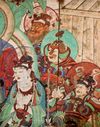
|
| الكهف 26 | تانگ | الأسر الخمس، سونگ، (date unclear), تشينگ | C18 | |
| الكهف 27 | تانگ | C18b | ||
| الكهف 28 | Early-تانگ | سونگ، شيا الغربية، تشينگ | C19 | |
| الكهف 29 | شيا الغربية | يوان، تشينگ | C20 | 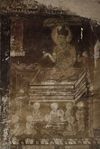
|
| الكهف 30 | Late-تانگ | سونگ | C20 | |
| الكهف 31 | الأسر الخمس | تشينگ | C21 | |
| الكهف 32 | الأسر الخمس | سونگ | C22 | 
|
| الكهف 33 | الأسر الخمس | تشينگ | C23 | |
| الكهف 34 | تانگ | الأسر الخمس، سونگ، تشينگ | C24 | |
| الكهف 35 | تانگ | الأسر الخمس، سونگ، تشينگ | C25 | |
| الكهف 36 | تانگ | الأسر الخمس، سونگ، تشينگ | C26 | |
| الكهف 37 | تشينگ | |||
| الكهف 38 | تانگ | الأسر الخمس، تشينگ | C27 | |
| الكهف 39 | تانگ | (date unclear), يوان، تشينگ | C28 | 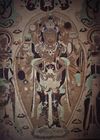
|
| الكهف 40 | الأسر الخمس | تشينگ | C29 | |
| الكهف 41 | الأسر الخمس | يوان، تشينگ | ||
| الكهف 42 | High-تانگ |
انظر أيضاً
- كهوف موگاو
- Principles for the Conservation of Heritage Sites in China
- National Heritage Sites in Gansu Province
- International Dunhuang Project
- مواقع التراث العالمي في الصين
الهامش
- ^ أ ب ت Fan Jinshi, ed. (1999). 安西榆林窟 The Anxi Yulin Grottoes (in Chinese and English). Gansu National Publishing House. pp. 6–9. ISBN 7542106465.
{{cite book}}: CS1 maint: unrecognized language (link) - ^ أ ب Dunhuang Academy, ed. (1997). 安西榆林窟 [Anxi Yulin Caves] (in Chinese). 文物出版社. ISBN 7501007748.
{{cite book}}: CS1 maint: unrecognized language (link) - ^ "国务院关于公布第一批全国重点文物保护单位名单的通知 (1st Designations)" (in Chinese). State Administration of Cultural Heritage. 3 April 1961. Archived from the original on June 9, 2012. Retrieved 27 April 2012.
{{cite web}}: CS1 maint: unrecognized language (link) - ^ "Chinese Section of the Silk Road". UNESCO. Retrieved 28 April 2012.
- ^ أ ب Whitfield, Roderick (et al.) (2000). Cave Temples of Mogao: Art and History on the Silk Road. Getty Conservation Institute. pp. 5, 114 ff, 135. ISBN 0892365854.
- ^ Dunhuang Academy, ed. (1997). 安西榆林窟 [Anxi Yulin Caves] (in Chinese). 文物出版社. pp. 254–263. ISBN 7501007748.
{{cite book}}: CS1 maint: unrecognized language (link) - ^ Dai Matsui (2008). "Revising the Uigur Inscriptions of the Yulin Caves". Studies on the Inner Asian Languages. Osaka University. 23: 17–33. ISSN 1341-5670.
وصلات خارجية
- CS1 uses الصينية-language script (zh)
- Pages using gadget WikiMiniAtlas
- Articles containing Chinese-language text
- Articles containing إنگليزية-language text
- Pages using Lang-xx templates
- Articles with صينية-language sources (zh)
- مغارات بوذية في گانسو
- رسم صيني
- ناحية گواژو
- فن أسرة تانگ
- معابد بوذية في أسرة تانگ
- عمارة شيا الغربية
- الأسر الخمس والممالك العشر
- مواقع تاريخية وثقافية وطنية رئيسية في گانسو
- Coordinates on Wikidata
